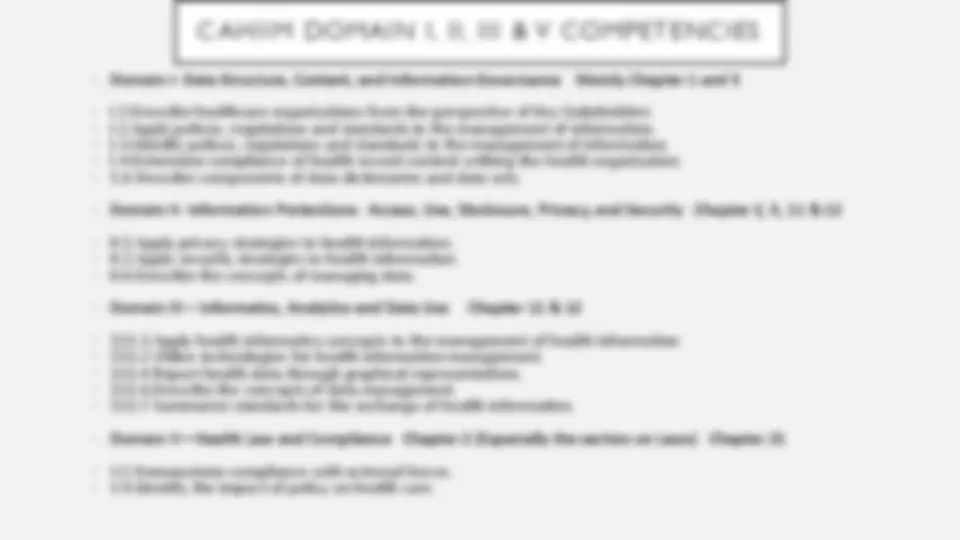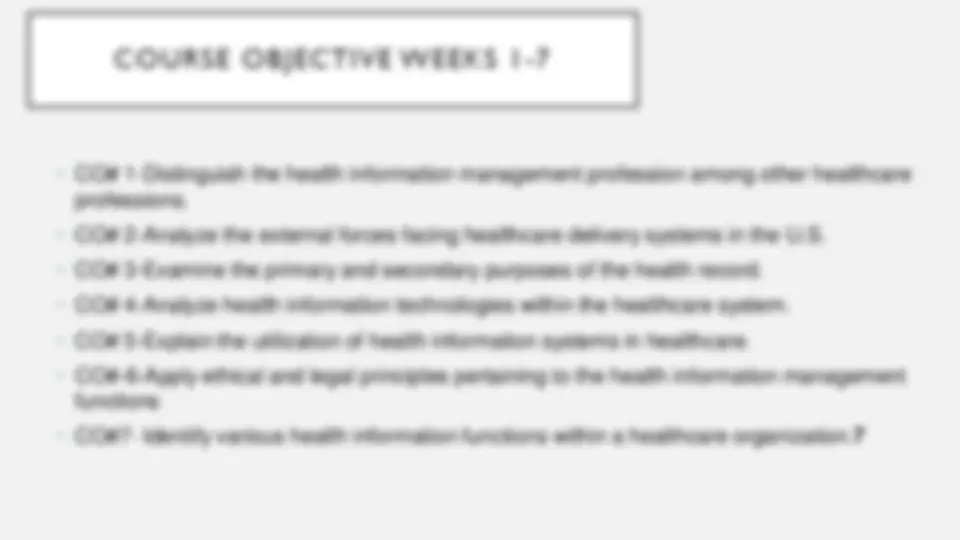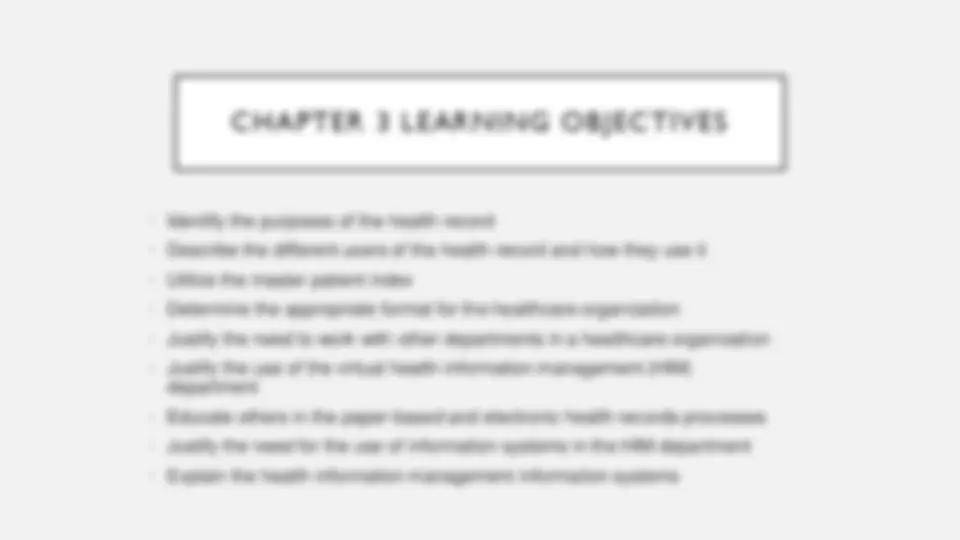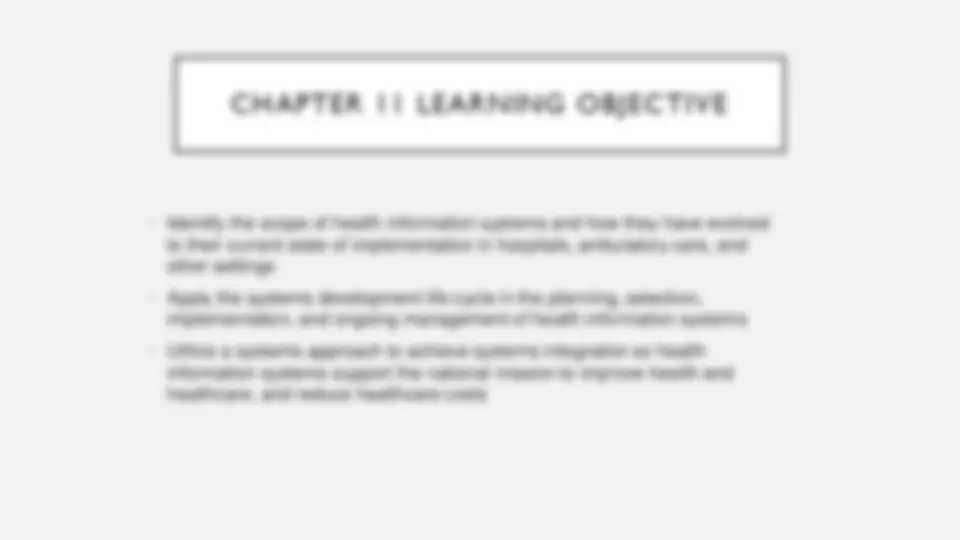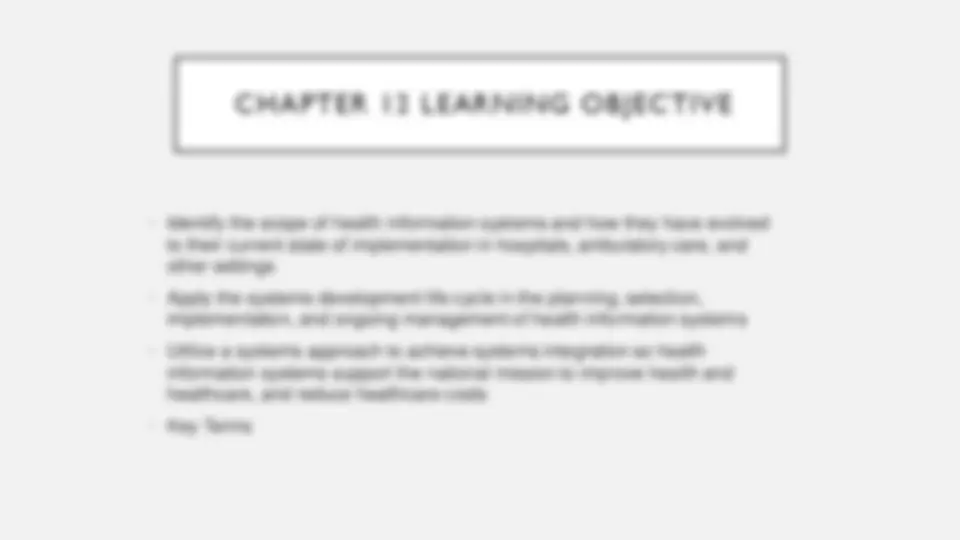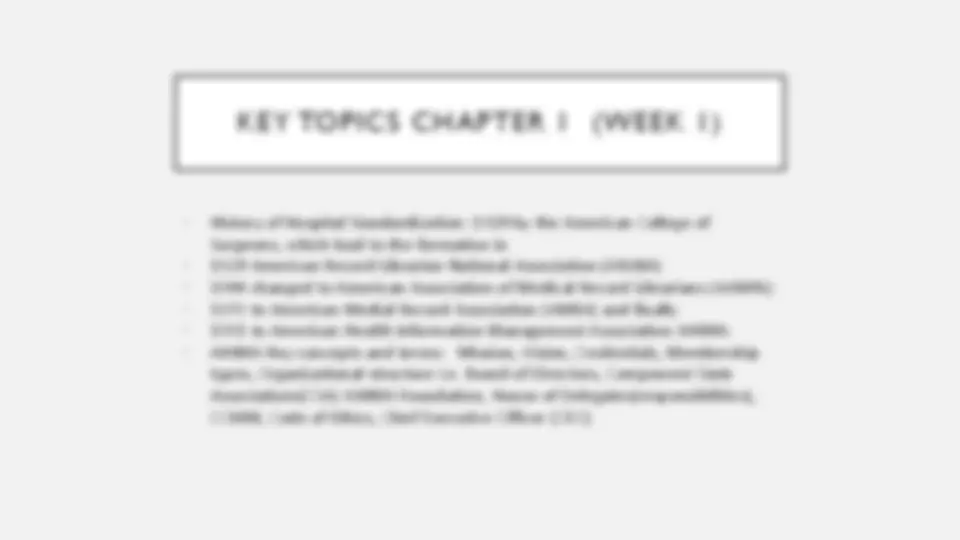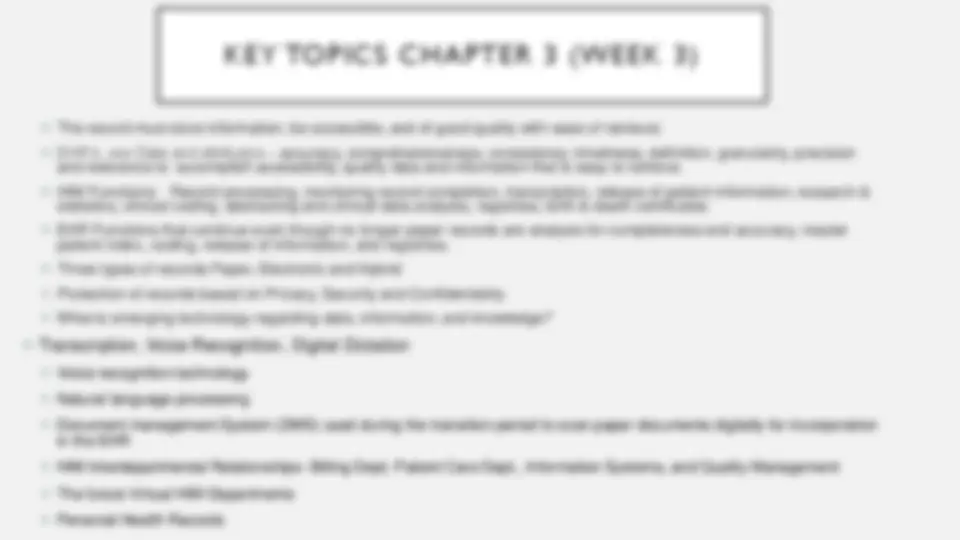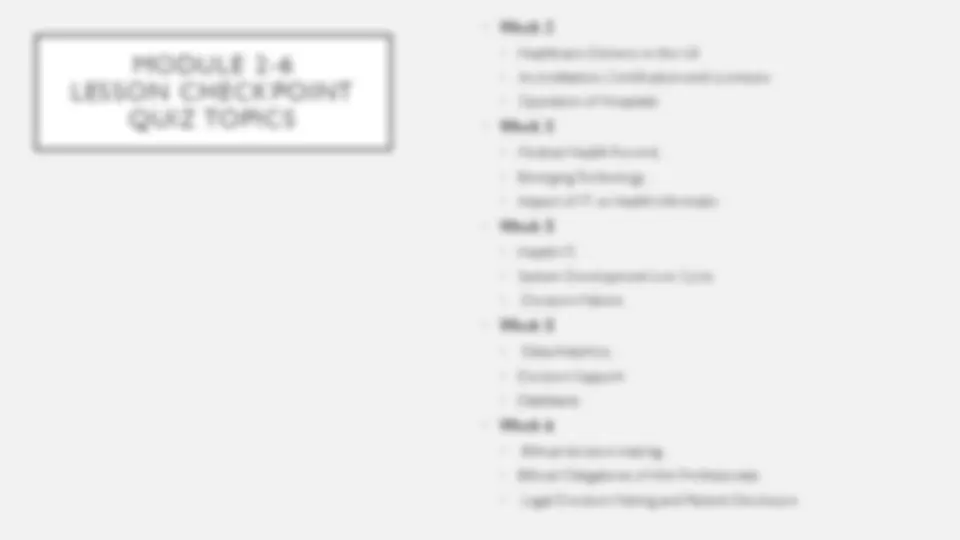Download Preparing for CAHIIM Quizzes: HIT 120 Health Information Systems and Technology and more Exams Medical Microbiology in PDF only on Docsity!
PREPARING FOR
THE WEEK 8
CAHIIM QUIZZES
HIT 120 HEALTH INFORMATION SYSTEMS AND
TECHNOLOGY
Presented on September 13
th
Live Lecture
4 C AH I I M E X AM QU I Z Z E S I N
W E E K 8 - D U E S AT U R D AY
D E C E M B E R 1 7 T H !!
D O M AI N I - 4 0 P OI N T S
D O M AI N I I - 4 0 P OI N T S ,
D OM AI N I I I - 4 0 P OI N T S
D O M AI N V- 4 0 P OI N T S
1 6 0 P OI N T S
ON E AT T E M P T P E R QU I Z
ON LY
N OT T I M E D
DUE AT MIDNIGHT SATURDAY OCTOBER 21 ST THIS IS THE LAST DAY OF CLASS
C AHIIM DOMAIN I, II, III & V COMPETENCIES
- Domain I- Data Structure, Content, and Information Governance Mainly Chapter 1 and 3
- I.1 Describe healthcare organizations from the perspective of Key Stakeholders
- I.2 Apply polices, regulations and standards to the management of information.
- I.3 Identify polices, regulations and standards to the management of information.
- I.4 Determine compliance of health record content withing the health organization.
- 1.6 Describe components of data dictionaries and data sets.
- Domain II- Information Protections: Access, Use, Disclosure, Privacy, and Security Chapter 2, 3, 11 & 12
- II.1 Apply privacy strategies to health information.
- II.2 Apply security strategies to health information.
- II.6 Describe the concepts of managing data.
- Domain III – Informatics, Analytics and Data Use Chapter 11 & 12
- 111.1 Apply health informatics concepts to the management of health information
- 111.2 Utilize technologies for health information management.
- 111.4 Report health data through graphical representations.
- 111.6 Describe the concepts of data management.
- 111.7 Summarize standards for the exchange of health information.
- Domain V—Health Law and Compliance Chapter 2 (Especially the section on Laws) Chapter 21
- V.2 Demonstrate compliance with external forces.
- V.4 Identify the impact of policy on health care.
COURSE OBJECTIVE WEEKS 1- 7
- CO# 1-Distinguish the health information management profession among other healthcare professions.
- CO# 2-Analyze the external forces facing healthcare delivery systems in the U.S.
- CO# 3-Examine the primary and secondary purposes of the health record.
- CO# 4-Analyze health information technologies within the healthcare system.
- CO# 5-Explain the utilization of health information systems in healthcare.
- CO#- 6 - Apply ethical and legal principles pertaining to the health information management functions
- CO#7- Identify various health information functions within a healthcare organization. 7
CHAPTER 2 LEARNING OBJECTIVES
- Differentiate the roles of various healthcare providers throughout the healthcare delivery system
- Determine the basic organization and operation of various types of hospitals and other healthcare organizations and services
- Examine the use and functions of telehealth services in healthcare
- Examine the influence of artificial intelligence in the delivery of healthcare
- Identify the various policy making influences in the delivery of healthcare
- Examine healthcare delivery in the United States
- Impact of Policy Making and Healthcare Delivery – Rules, Acts, Laws
CHAPTER 3 LEARNING OBJECTIVES
- Identify the purposes of the health record
- Describe the different users of the health record and how they use it
- Utilize the master patient index
- Determine the appropriate format for the healthcare organization
- Justify the need to work with other departments in a healthcare organization
- Justify the use of the virtual health information management (HIM) department
- Educate others in the paper-based and electronic health records processes
- Justify the need for the use of information systems in the HIM department
- Explain the health information management information systems
CHAPTER 12 LEARNING OBJECTIVE
- Identify the scope of health information systems and how they have evolved to their current state of implementation in hospitals, ambulatory care, and other settings
- Apply the systems development life cycle in the planning, selection, implementation, and ongoing management of health information systems
- Utilize a systems approach to achieve systems integration so health information systems support the national mission to improve health and healthcare, and reduce healthcare costs
- Key Terms
CHAPTER 21 LEARNING OBJECTIVES
- Examine moral values and ethical principles
- Interpret the concepts of morality code of conduct, and moral judgment
- Identify how cultural issues affect health and healthcare quality, cost, and health information management
- Identify cultural competence for healthcare professionals
- Examine the ethical foundations of health information management
- Examine the American Health Information Management Association’s (AHIMA) Code of Ethics
- Examine ethical issues related to medical identity theft
- Evaluate the process of ethical decision-making
- Demonstrate methods used to resolve a breach of healthcare ethics
- Identify the important health information ethical problems in healthcare
KEY TOPICS CHAPTER 1 (WEEK 1)
- History of Hospital Standardization: 1918 by the American College of Surgeons, which lead to the formation in
- 1928 American Record Librarian National Association (ARLNA)
- 1944 changed to American Association of Medical Record Librarians (AAMRL)
- 1970 to American Medial Record Association (AMRA) and finally
- 1991 to American Health Information Management Association AHIMA.
- AHIMA Key concepts and terms: Mission, Vision, Credentials, Membership types, Organizational structure i.e. Board of Directors, Component State Associations(CSA) AHIMA Foundation, House of Delegates(responsibilities), CCHIM, Code of Ethics, Chief Executive Officer (CEO)
KEY TOPICS CHAPTER 2 (WEEK 1 & 2)
- Healthcare Delivery Systems - System
- Standardization of Medical Care
- Integrated Delivery System (IDS)
- physicians/specialists
- allied health professional ,
- PA’s and NP’s,
- nursing practice, RN (can be associate or bachelor degree), LPN
KEY TOPICS CHAPTER 11(WEEK 4) ❖ Healthcare data analytics is the practice of using data to make business decisions in healthcare. ❖ Clinical data analytics is the process by which health information is captured, reviewed and use to measure quality of care provided. ❖ Analytic tools – Data visualization, Dashboards ❖ Data capture is the processing of recording data in a health record system or database. A database is an organized collection of data, text, references or pictures in a standardized format. ❖ Structured and unstructured data, discrete data, data mining ❖ Decision Support : Decision Support System(DSS), Clinical Decision Support System (CDDS), and Executive Information System(EIS) ❖ Quality Measurement ❖ Clinical Research ❖ Consumers and healthcare information
KEY TOPICS CHAPTER 12 (WEEK 5) ❖ Federal Health IT Strategic Plan – ONC for Health Info Technology ❖ Health IT Categories – Source systems, core clinical EHR, Supporting infrastructure, and connective systems ❖ Source Systems – Administrative and financial applications - Review these systems HIS, R-ADT, PFS, RCM, See Figure 11. ❖ Core Clinical EHR Systems - See Figure 11.5 CPOE, Bc-MAR, CDSS, NIS, CDS ❖ Specialty systems and automated devices-PACSs DICOM ❖ Supporting Infrastructure ❖ Connectivity Systems, Patient Portals, Telehealth ❖ HIE – Health Information Exchanges and HIO Health Information Organizations ❖ System Development Life Cycle (SDLC)–Identify, Specify, Design, Develop, Maintain and Monitor ❖ SMART Goals – Specific, Measurable, Attainable, Relevant, and Time-based
MODULE 2- 6 LESSON CHECKPOINT QUIZ TOPICS
- Week 2
- Healthcare Delivery in the US
- Accreditation, Certification and Licensure
- Operation of Hospitals
- Week 3
- Medical Health Record,
- Emerging Technology,
- Impact of IT on health Informatic
- Week 5
- Health IT,
- System Development Live Cycle
- Decision Makers
- Week 5
- Data Analytics,
- Decision Support
- Databases
- Week 6
- Ethical decision making,
- Ethical Obligations of Him Professionals
- Legal Decision Making and Patient Disclosure


